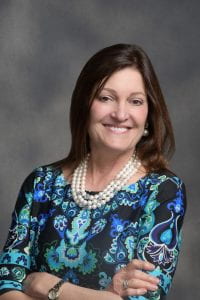Before joining the Indiana University Kelley School of Business in 2002, initially as a lecturer, Ann Bastianelli, spent more than 30 years in advertising and marketing.
Campaigns she worked on include many of the classics of American consumer products advertising. They include the “Two Scoops of Raisins” campaign for Kellogg’s Raisin Bran, the “talking Parkay” margarine ads for Kraft, and Dow Bathroom Cleaner’s “Scrubbing Bubbles.” Your kids may have loved their Happy Meal at McDonalds through her work with Leo Burnett.
Bastianelli, today a teaching professor of marketing, remains in tune with the latest in advertising and marketing trends. Here’s what she expects to see this Super Bowl Sunday, the biggest day of the year in advertising.
Continue to look to laugh

Viewers should “look for absurdist humor that gets people to laugh out loud, stories of kindness and empathy — everyday enjoyment,” she said, adding that patriotism may not be a big theme this year.
“The wounds are still raw from January 6, 2021, and inflation and lingering threats of Covid hotspots are ever present worries,” Bastianelli said. “One-third of adults are stressed to the point that everyday decisions are overwhelming. Half of them believe that planning for the future is futile. We’ve seen increases in hoarding, pandemic-driven DIY, anxieties about the future of the democracy, and job resignations.
“Differences in financial resources, race, gender or sexual orientation have exaggerated the different ways the global population has experienced the pandemic,” she said. “Brands must meet people where they are. Advertisers in the Super Bowl may tap into this opportunity to express compassion and understanding that while we’re not all in the same boat, we are in the same storm.”
This includes recognizing that the pandemic has changed the way many look at life, leading to different lifestyle choices, including more attention to feeling like “human beings, rather than human doings.”
“Rather than grinding out more in productivity, people are reconsidering and rejecting the never-ending pursuit of corporate profit and productivity. Some even find it unethical. Life balance and emotional health are more often prioritized over stereotypical achievement,” Bastianelli said. “This explains job resignations, dropping out, opting out of the workforce, and drags on the mental health system.
“Philosophies centered on self-control are in. Specifically, Pop-Stoicism is a conviction that takes the balanced perspective that life is short, what doesn’t kill us makes us stronger, and clear, unbiased thinking is the true path to understanding universal reason,” she added. “If this leaning toward keeping a stiff upper lip continues, it’s likely that trends such as sustainability and purpose-driven brands will be around for a while.”
More expected from brands
She said a “giving brand” is so much more attractive than a “taking brand.”
“Consumers are fascinated by brands that give them what they need, making them feel cared for, instead of taking from them what the brand needs — like money and loyalty. This makes consumers feel taken advantage of,” Bastianelli said. “Consumers are more skeptical and cynical than they’ve been in the past. Fact-led consumers crave knowledge and credibility. When a company or brand promises transparency or authenticity, there had better be plenty of evidence that they mean what they say and are doing as they say they will.”
There is comfort and reassurance in objectivity. So, ads with a well-structured narrative, realistic promises of real value, credible reasons to believe, and proof of transparency and authenticity are table stakes.
Luxury brands will need to meet customer expectations of extreme comfort, sustainability and beautiful workmanship.
“Those products should also be thoughtful and ideally, serve a higher purpose,” she said “People are conflicted about conspicuous consumption and reasonableness. Look at the rise in popularity of the secondhand economy, renting vs. owning and collective consumerism.”
More needs to be done for female fans
Women are more than half of the U.S. population and account for roughly 47% of Super Bowl viewership. Over the last decade, advertisers have tried to be more intentional about representation and portrayals of women in Super Bowl ads.
“More than just feeling appreciative of improved opportunities, women are just as enthused about body positivity and putting patriarchy in its place by holding men accountable for chauvinistic behavior — past and present,” she said.
Truly equal representation in Super Bowl ads remains rare. “Men get about two and half times more speaking time than females in Super Bowl spots. And men are about twice as likely as women to be portrayed as leaders,” she said.
Bastianelli cited statistics indicating that when women are on screen, they are 10 times as likely to be dressed in revealing clothing and three times as likely to appear partially nude. Additionally, age discrimination and sexism are evident. Male characters are twice as likely to be portrayed as 40 or older (43.2% compared with 22.6%). Seventy four percent of women cast are under forty.
“Why does this matter? Equal representation isn’t just the right thing to do, it’s good business-sense,” Bastianelli said. “Videos on YouTube that feature female-led and gender-balanced content get 30% more views than e male-dominated videos, yet more than half of the YouTube content is male dominated.”
Previous ads she has liked include Olay’s 2020 campaign, “Make Space for Women,” which featured an all-female cast and was tied to a Twitter campaign; and Secret deodorant’s “All Strength, No Sweat” ad featuring world-class female athletes that showed women what a world of equal possibility could look like.
When it comes to equity and inclusion, her vote for the most effective and resonant ad campaign is “Like a Girl” from Always, which shined a light on the social barriers facing girls beginning in puberty and continuing throughout their lives.
